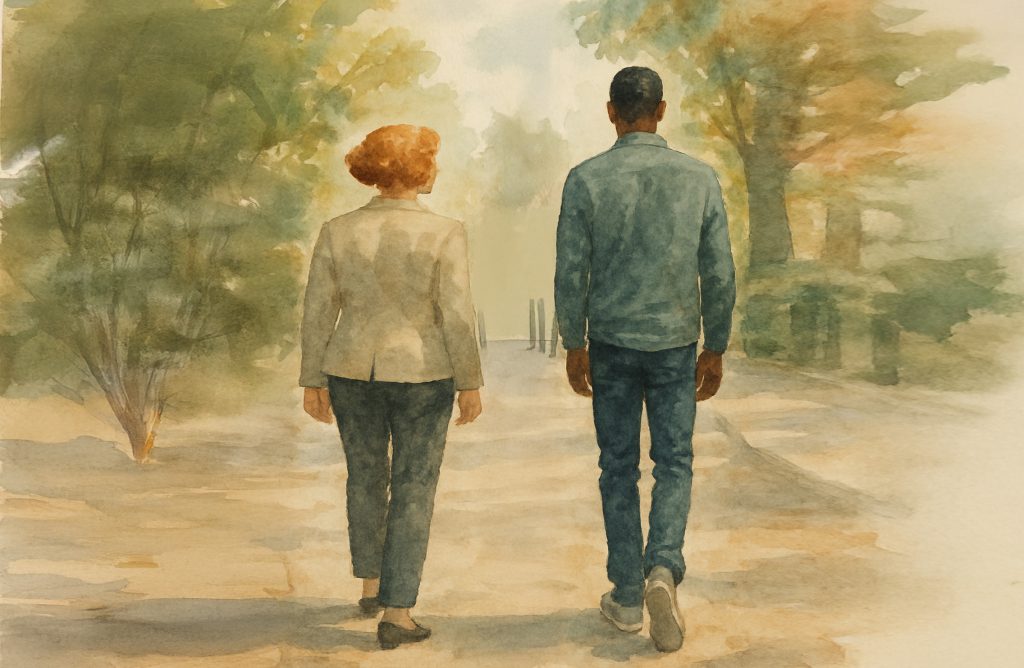
Why the urge to leave (or disappear) is a meaningful part of the work
Let’s talk about those moments in therapy when everything in you says: “I have to get out of here.” Not metaphorically, literally! I mean your actual legs twitch, your heart starts sprinting, maybe the walls close in, and you’re already halfway through planning your exit route. It’s not always dramatic on the outside, but internally it can feel like your whole system is bolting for the door. And honestly? That’s not you being “difficult” or “doing therapy wrong”. It’s not failure. It’s a signal, a flare going up from some remembered part of your past that’s now living in your body.
What might look like a dramatic escape impulse could actually be a body memory, your system remembering what it once couldn’t flee. Therapy pokes at things sometimes, often gently, sometimes by accident, the body doesn’t need full context. It just knows something feels off, and I need to move.
We can work with that.
I might say something like “What would happen if we actually honoured that feeling? What if we walked?” Literally walked. You and me. Round the block. Because sometimes the most healing thing is not sitting through the storm, it’s walking it out. Letting your body do the thing it once couldn’t do, escape, safely and with company this time.
There’s nothing performative about that. It’s not “acting out.” It’s acting with awareness. You’re not just being pushed by trauma anymore, you’re choosing to move with it, alongside someone who will walk with you.
And gradually, over time, that walking impulse might feel a little less urgent. You might learn you can stay. Or you might still need to leave and know you can do that in a way that doesn’t sever the therapy. Because therapy isn’t about containment at all costs. It’s about building safety in whatever shape it needs to take.
When You Go Quiet: Working with Shutdown in Therapy
Now, let’s flip the script.
Not everyone bolts when they hit overwhelm. Some people vanish in place. The eyes glaze. The muscles go still. The world goes muffled. Sometimes you know it’s happening. Sometimes you only notice when the session’s over and you’ve no idea what was said.
This isn’t failure either. This is often what people call shutdown, but it can also be a form of dissociation, a subtle slipping away when things feel too much. Sometimes it’s your system protecting you from feelings that would be too sharp to touch directly. Sometimes it’s your body replaying what it learned long ago: when in danger, disappear.
But here’s the part no one tells you: dissociation isn’t just disconnection. It’s communication. It’s your body saying, “I remember this. I know this feeling. And I’m trying to protect you the only way I know how.”
So, what do we do when that happens in therapy?
We stay close. Not by shaking you out of it. Not by urgently “grounding” or pulling you back up the ladder of regulation (though sometimes we might do those things too), but by being with you, without trying to fix you.
I might say something like, “You don’t have to talk. I’m here. If words come, I’ll hear them. If they don’t, that’s okay too.”
There’s something incredibly powerful about being met in your dissociation without shame. Noticed, not nudged. Seen, not solved. It says to that deep part of you: “You’re allowed to be exactly like this. And someone still stays.”
Over time, that gentle contact can bring just enough space to notice, “Oh, this is what it feels like to shut down,” and eventually, “I wonder what this part of me is afraid of?” We’re not suppressing the response. We’re making room to get curious about it. To listen to what it’s protecting.
Staying Present When You’re Not Really Here
Whether your impulse is to flee the room or vanish within it, the goal in therapy isn’t to not have those responses. The goal is to build enough safety that you start to notice them. To say: “There I go. That’s my body remembering something”, And then, if it feels right: “What do I want to do with that now?”
Sometimes the answer is walk. Sometimes it’s talk. Sometimes it’s silence. Sometimes it’s a cushion-punch and a bit of swearing.
What matters is not forcing yourself to perform healing.
It’s knowing you don’t have to “be good” to be supported.
You don’t have to hold it together to be worthy of help.
You don’t even have to stay in the room.
You just have to be in a space where all your parts, quiet, scared, frozen, furious, wordless, are welcome.
And I’ll Walk with you, if that helps.
